IATI members’ efforts in improving traceability
We spoke to John Adams at the UK Department for International Development and Chair of IATI’s Technical Advisory Group, Pelle Aardema and Herman van Loon for the Netherlands MFA, and Martin Akerman at UNFPA about the progress made on their multi-stakeholder project to improve traceability.
Back in 2016 IATI members, including the Netherlands, UNFPA and the UK agreed to increase their efforts on improving traceability. Together, they’ve explored how to use IATI data to track development funds from one organisation to another throughout complex delivery chains.
To date over 600 organisations have published information on their humanitarian and development spending and activities to IATI. The IATI Standard plays an important role in achieving traceability by allowing organisations to communicate like-for-like on key data elements such as financial transactions, participating organisations, results, geographic location and thematic purposes related to projects.
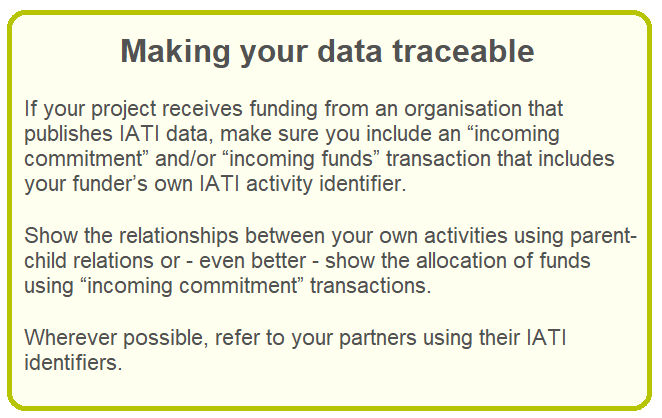
Many international development organisations have been actively publishing and using IATI data for quite some time. However, despite the progress made, they’ve not been able to address linkages between activities carried out by different organisations – so that a contribution from a donor could link to the activities reported by a partner along the delivery chain.
This ability to trace activities along these delivery chains is called “traceability”.
Why is traceability important?
Traceability is one key element in tracking the results or impact of projects, which is increasingly driving funding decisions in the sector.
Expenditures and end-of-year reports used to be manually processed and for the most part, linkages between expenditures and outcomes were approximated. This has been changed through the introduction of results-based management approaches (GPRA-MA in the United States and other examples from around the world) and faster public information systems that started to make their way into government a few years ago.
Today, budgets are being tied to specific targets, and the ability to leverage information systems and open data across organisations means that partners can manage and coordinate more data around risks and results faster than ever.
If you’re looking for proof of what’s next in development financing, the humanitarian sector is the tip of the spear, where needs drive nearly every funding decision, and emerging challenges and results are expected to be communicated on a real-time basis. We are working to build a culture of trust and value-for-money at a key moment in time.
What progress has been made on traceability?
UNFPA
After several rounds of engagement with donors, UNFPA, the United Nations Population Fund, was able to link datasets across organisations using IATI, providing for an unprecedented level of assurance and traceability on core-funded activities.
If donors are able to provide UNFPA with their related IATI activity identifiers, they can trace results achieved and financial data which helps to track the disbursement throughout the delivery chain; including the country, sectors/thematic areas in OECD/DAC and SDG sector vocabulary, planned budget expenditures, and documents related to programme delivery and evaluation.
In order to allow for traceability throughout the entire delivery chain, UNFPA encourages implementing partners to publish information related to development activities to the IATI Registry, with reference to our corresponding IATI identification numbers.
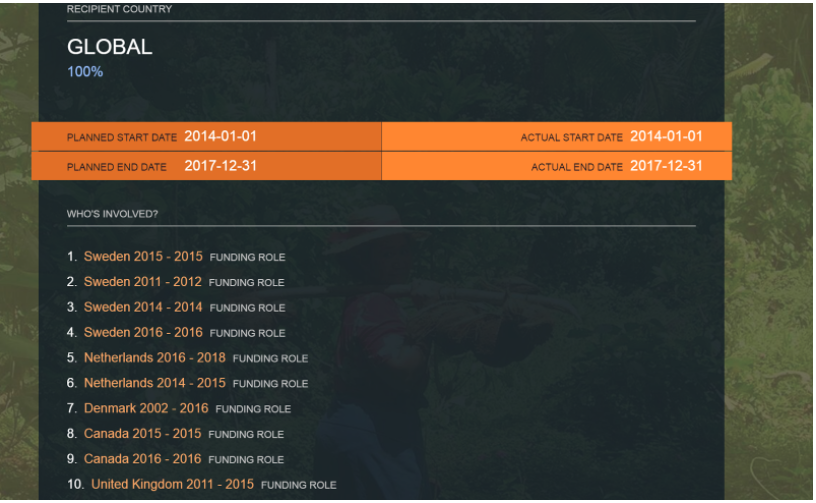
The traceability pilot has been successful in allowing UNFPA to prove that it can streamline information collection, help avoid double-reporting, reduce traditional manual data entry and allow for more efficient coordination of development activities.
Netherlands Ministry of Foreign Affairs
Since January 1st, 2016 the Directorate-General of International Cooperation (DGIS) within the Netherlands Ministry of Foreign Affairs has made it mandatory for partners, contractors and suppliers to report progress for all ODA activities over €250.000 using the IATI Standard.
Over the past 2 years DGIS has worked with many partner organisations to publish IATI data according to our publication guidelines. These guidelines describe different use cases, such as programmatic funding, where traceability is a key element to understand what is happening.
Currently DGIS is able to automatically process the IATI data of over a hundred partners – including large NGOs and some multilateral organisations – with many more partners working towards an ‘A-grade’ IATI publication. In this process they are supported by the ministry’s open data helpdesk. The partners’ data are then linked to DGIS open data and displayed in a custom built dashboard ‘METIS’.
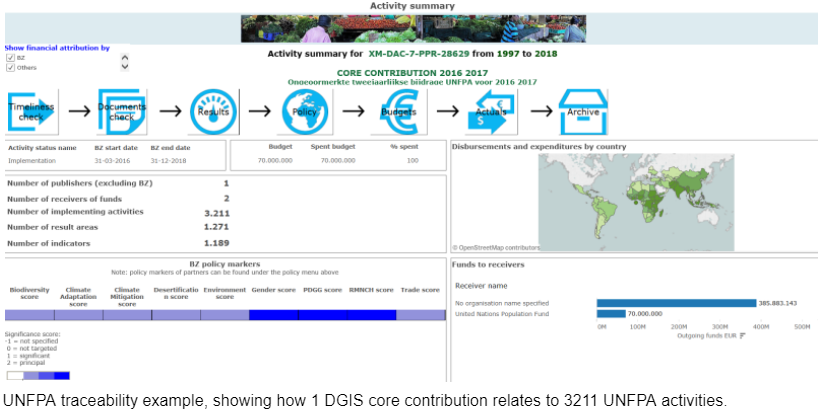
DGIS policy officers use these dashboards to monitor and assess the progress of the activities they support. Many partners have started to publish the results achieved as IATI data. The visualizations based on the IATI data and METIS dashboards also give an insight into the complexity of some of the activities and in the network of organisations involved, increasing the transparency of the relations between organisations in the network. The network connections are calculated based on the transactions between organisations.
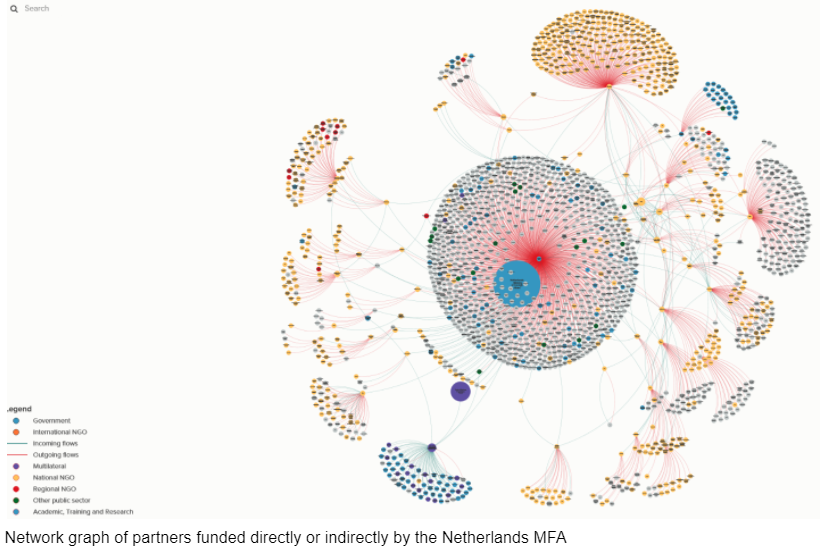
Over the next few months the Netherlands MFA will be working on an update of the publication guidelines, in close coordination with DFID and other donors and partners. Further work is being done to create specific country insights or thematic insights based on the available data.
UK Department for International Development
In common with the Netherlands, the UK has made it mandatory for all organisations receiving international development funding to publish information about their activities as IATI data. Working closely with a team from Zimmerman & Zimmerman and Open Data Service Co-op, DFID reviewed our key partners to understand who is publishing IATI, whether they link up to DFID funding, and if we can build traceability maps.
We developed tools to examine the delivery chain, for example to generate tree diagrams visualising the activities involved in the chain.
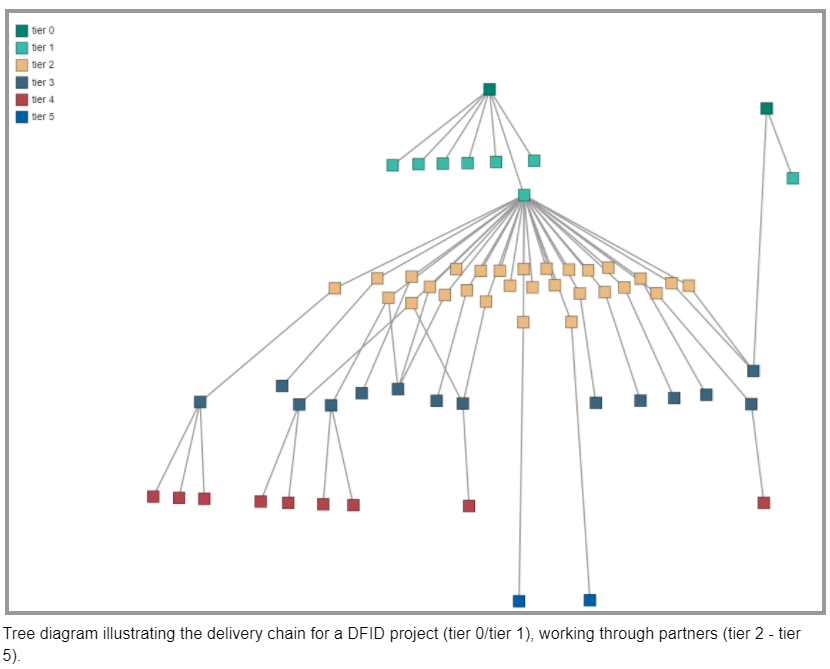
The next step is to embed these delivery chains in internal tools, providing DFID programme managers with the ability to view the data produced by partners, and to use that information to measure progress, challenge data quality and understand the complexity of their programmes. We will also embed the delivery chains in Development Tracker, so that partners can also use the data to make linkages and improve quality.
Alongside this, we will be releasing updated guidelines for partners to support them in publishing traceable activities in IATI.